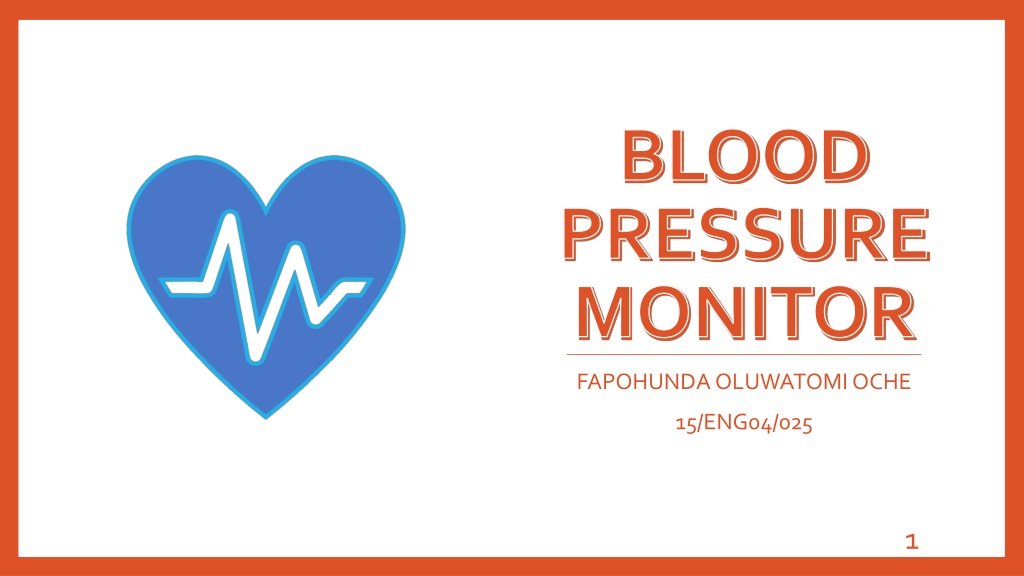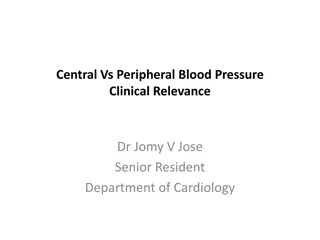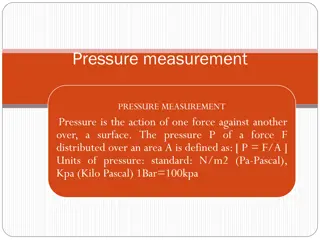Understanding Blood Pressure Monitoring
Blood pressure monitoring is essential for maintaining overall health. This article explores the significance of blood pressure, the importance of monitoring it, and the methods used to measure blood pressure. It also delves into the clinical need for accurate blood pressure monitoring devices and the history of early blood pressure measurement tools.
Download Presentation

Please find below an Image/Link to download the presentation.
The content on the website is provided AS IS for your information and personal use only. It may not be sold, licensed, or shared on other websites without obtaining consent from the author. Download presentation by click this link. If you encounter any issues during the download, it is possible that the publisher has removed the file from their server.
E N D
Presentation Transcript
BLOOD PRESSURE MONITOR FAPOHUNDA OLUWATOMI OCHE 15/ENG04/025 1
Introduction If you lined up all the blood vessels in your body they will be 95,000 kilometers long Everyday they carry the equivalent of over 7,500 liters of blood although that is the same 4 or 5 liters recycled over and over The blood delivers oxygen and nutrients such as glucose and amino acids to the body s tissues All that blood exerts a force on the muscular walls of the blood vessels and it is called blood pressure 2
Introduction Blood pressure rises and falls with the phases of the heartbeat. When the heart contracts it is systole and when the heart relaxes it is diastole A typical healthy person has a systole of 90 to 120mmHg and a diastole of 60 to 80mmHg A blood pressure monitor is an instrument that enables systolic, diastolic, and often mean blood pressures to be measured and displayed 3
Clinical Need An estimated 1.13 billion people worldwide have hypertension, most (two-thirds) living in low- and middle-income countries. In 2015, 1 in 4 men and 1 in 5 women had hypertension. Fewer than 1 in 5 people with hypertension have the problem under control. Hypertension is a major cause of premature death worldwide. One of the global targets for noncommunicable diseases is to reduce the prevalence of hypertension by 25% by 2025. 4
Methods of Measuring Blood Pressure (BP) Oxygenated blood is ejected from the left ventricle during each cardiac beat and travels from the aorta to smaller arteries, arterioles, and capillaries. Figure 0: The pressure contour changes as a pressure wave travels from the aorta toward smaller vessels Blood pressure is typically measured either at the brachial artery using auscultation or oscillometry, or at the radial artery using an intraarterial pressure (IAP) sensor (Blood pressure sensor) 5
Early Devices Although BP could be measured directly when a pressure sensor was in contact with blood, this was not a convenient measurement. In 1881, Austrian physician Samuel von Basch connected a mercury column manometer to a water-filled bag, which was called a sphygmomanometer. In 1886, Italian internist Scipione Riva-Rocci improved the sphygmomanometer design. Riva-Rocci s apparatus consisted of a mercury manometer, an arm- encircling inflatable elastic cuff, and a rubber bulb to inflate the cuff. With this device, Riva-Rocci estimated systolic pressure by determining the cuff pressure at which the radial pressure could not be felt. 6
Early Devices In 1905, Nikolai Korotkoff improved Riva-Rocci s method by discovering a more accurate pressure marker during cuff deflation using Korotkoff sounds. Auscultation is still considered the reference standard for non-invasive BP measurement in 1977, Maynard Mike Ramsey III developed the first automated BP monitor, based on oscillometry 7
Patient Monitors Figure 1: Philips Intellivue MP50 Patient Monitor with optional Multi-measurement Module (top left) that provides oscillometric and arterial blood pressure measurements: The MP50 is part of a family of patient monitors (MP20MP70) that are optimized for various patient care environments and are used in conjunction with an instrument measuring blood pressure Features: Enhanced user interface offers quick visibility of patient data, NBP measurement display for comprehensive overview, Flexible ECG handling simplifies diagnostics & reporting, Flexible ECG handling simplifies diagnostics & reporting, Clinical excellence with Multi-Measurement Module and extensions, Touchscreen* simplifies tasks, Color display shows key data at a glance, IntelliVue portal technology for access across the network and Portable design for comfort and dependability 8
Other Patient Monitors Commercially Available Philips - IntelliVue MX800 Bedside patient monitor: Integrated PC and monitor in one offers one intuitive view, Easy to use to save time and effort and Smooth design supports infection control protocols Philips - SureSigns VM8 Bedside patient monitor: Wide variety of measurements makes VM8 your go-to monitor, Lithium ion battery for power on the go and Optional integral recorder to monitor trends Fukuda - DYNASCOPE DS-8100 : Integrated monitor with a 10 inch wide colour display, Compact and ultra slim, designed to fit every critical area and Maximum 3 hours battery operation is possible 9
Blood Pressure Sensor/Transducer The invasive reference standard for BP measurement is the blood pressure sensor A BP transducer has an operating range of 230 to 1300 mmHg and a frequency range of 0 to 200 Hz Typically, a disposable BP transducer (Figure 2) connects to the patient through a catheter sitting in the radial artery and connects to a BP monitor (Figure 1) through a reusable electrical cable (Figure 3). The tubing length and the presence of air bubbles must be minimized, so that the system frequency response is not degraded. 10
Blood Pressure Sensor/Transducer Figure 2: Philips M1567 singleline blood pressure kit connects to the Multi- measurement module in Figure 1 Figure 3: Intraarterial pressure transducer system diagram 11
Auscultation The non-invasive reference standard for BP measurement is auscultation. A sphygmomanometer cuff over the brachial artery is inflated above the systolic pressure with a rubber bulb, and it is then slowly deflated (Figure 4). During deflation, the clinician listens with a stethoscope for Korotkoff sounds below the cuff and observes the corresponding aneroid manometer pressures. When the deflation pressure equals the systolic pressure, the sound of blood spurting under the cuff is heard. As the deflation pressure decreases and equals the diastolic pressure, the muffled sound transitions to silence (Figures 5). 12
Auscultation To acquire accurate blood pressure readings, the correct size cuff must be used to evenly transmit pressure to the brachial artery. The clinician must be able to hear the sounds, which means she must have good hearing and be listening in a quiet environment. For hypotensive patients, the sounds are lower frequency, and they may not be correctly heard. 13
Auscultation Figure 4: Welch Allyn Platinum Series DS48A pocket aneroid sphygmomanometer Figure 5: Auscultation system diagram. 14
Oscillometry Automated noninvasive BP monitors are most commonly based on oscillometry An appropriate size cuff over the brachial artery (Figure 6) is inflated above the systolic pressure and slowly deflated. During deflation, a pressure sensor in the cuff transmits pressure pulses to an amplifier. The amplified pressures are digitized and then processed to determine systolic, mean, and diastolic pressures. The pressure at which pulsatile pressures begin is generally designated as the systolic pressure. The pressure at which pulsatile pressures disappear, or a similar pressure disappears, is designated as the diastolic pressure (Figure 7). 15
Oscillometry As with auscultation, the correct cuff size must be used to evenly distribute pressure. For accurate pressure sensor measurement, the artery marking on the cuff should be correctly centred over the inner upper arm, with no clothing between the cuff and arm. The patient should be seated with his brachial artery at the level of the right atrium. He should not move during the measurement, as motion artifact may result in an inaccurate reading. Clinicians should realize that the diastolic reading is the least accurate, subject to diastolic pressure algorithm implementation. 16
Oscillometry Figure 6: Philips M157xA cuffs connect to the Multi-measurement module in Figure 1 through interconnect tubing Figure 7:Oscillometry system diagram. 17
Key Features Monitor Life: monitor should maintain its safety and performance characteristics for a reasonable length of time. Monitor Cuff Pressures: monitors with an occluding cuff must not harm the patient during use through unnecessary applied pressure. Monitor Accuracy with Auscultatory Method as Reference Standard Monitor Accuracy with Intraarterial Method as Reference Standard Transducer Accuracy 18
Ethical Issues Collecting BP data from people in any kind of study requires; Research staff to be properly trained Information to be provided to participants both verbally and non verbally in non- patronizing language (a 12 year old should be able to understand it) Consent forms should be signed Financial and other reward should be awarded Results should be communicated with participant and confidential 19
Engineering Standards As of 2010, the FDA recommends two AAMI standards for blood pressure measurement. The first applies to BP measurements that use an occluding cuff: ANSI/AAMI SP10:2002/(R)2008 Manual, Electronic, or Automated Sphygmomanometers (AAMI, 2008). The second applies to BP measurements that use an indwelling catheter: ANSI/AAMI BP22:1994/(R)2006 Blood Pressure Transducers (AAMI, 2006). 20
Conclusion Blood pressure may be measured either noninvasively or invasively, with a pressure sensor in contact with the blood. The two methods are auscultation and oscillometry An estimated 1.13 billion people worldwide have hypertension. Blood predicts cardiovascular risk. For every 20 mmHg systolic or 10 mmHg diastolic increase, the mortality from both ischemic (restricted blood flow) heart disease and stroke doubles. 21
References BAURA, G. D. (2012). MEDICAL DEVICE TECHNOLOGIES. Massachusetts: Elsevier Inc. CDC. (2018). Statistics: Hypertension. Retrieved from CDC. Saving Lives Protecting People: https://www.cdc.gov/bloodpressure/facts.htm CUREC. (2016). Studies Involving the Non-invasive Measurement of Blood Pressure in. Central University Research Ethics Committee (CUREC), 5. WHO. (2017). Details: Hypertension. Retrieved from WHO. Better health for everyone, everywhere: https://www.who.int/news-room/fact- sheets/detail/hypertension Philips. (2004-2020). Specifications: Intellivue. Retrieved from Philips: https://www.philips.ie/healthcare/product/HC862116/intellivue-mp40-and- mp50-bedside-patient-monitors/specifications 1. 2. 3. 4. 5. 22























